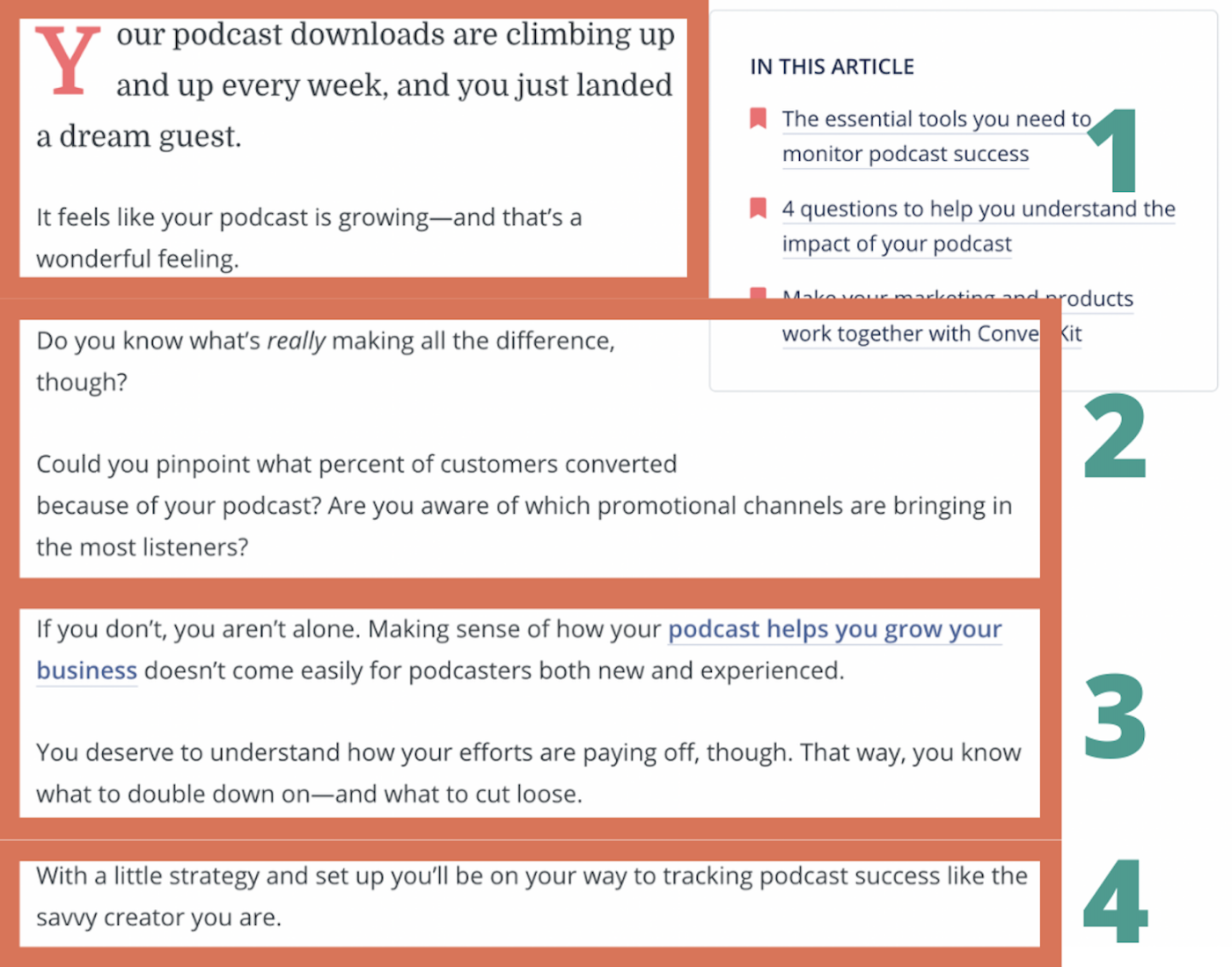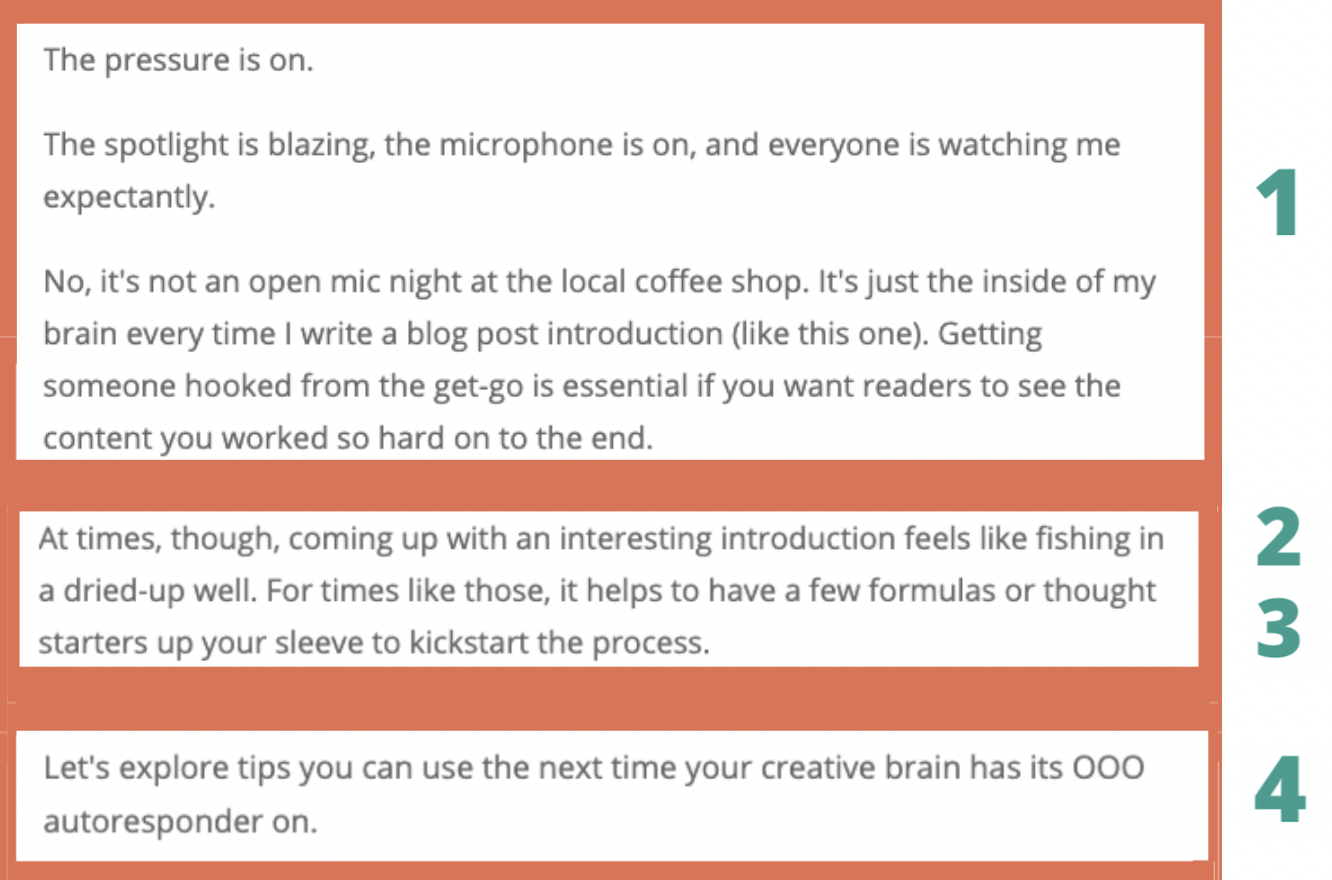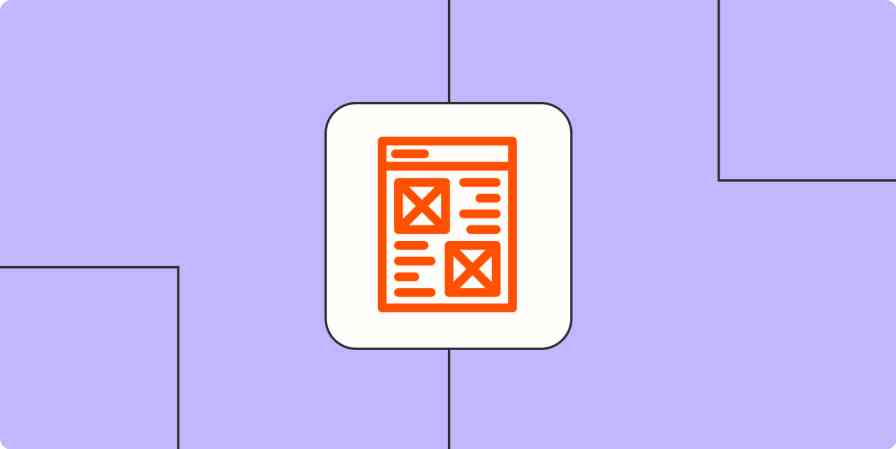The pressure is on.
The spotlight is blazing, the microphone is on, and everyone is watching me expectantly.
No, it's not an open mic night at the local coffee shop. It's just the inside of my brain every time I write a blog post introduction (like this one). Getting someone hooked from the get-go is essential if you want readers to see the content you worked so hard on to the end.
At times, though, coming up with an interesting introduction feels like fishing in a dried-up well. For times like those, it helps to have a few formulas or thought starters up your sleeve to kickstart the process.
Let's explore tips you can use the next time your creative brain has its OOO autoresponder on.
What a blog post introduction needs to achieve
Understanding what an introduction needs to do helps you gauge whether you've hit the mark (and can call a draft "done"). I have three goals each time I start a blog post:
Excite readers and give them a reason to read more
Introduce a new perspective on the topic
Set expectations about what a reader will learn
Keep this in mind, though: your blog post intro should achieve these goals quickly. After you've written your introduction, read it through again and see if you can delete any sentences—or even paragraphs—without losing any meaning or effect.
A 4-part formula to make writing introductions easier
Every time you sit down to write a new blog introduction, you have to create something unique and compelling. There's no "hacking" effective writing, but there are guidelines that can help you along.
I've broken down the intro-writing process into four components. Review these best practices, try using the formula, and then adapt it to your writing style.
1. Opener
First up: a line or two to catch someone's attention. If you struggle to come up with a great first sentence, wait until the draft is ready. Then write something that plays off an angle in the content.
Do use a personal story or analogy to make it interesting.
Don't state the obvious. Sentences along the lines of "We've all seen…" or "X is a well-established trend…" are redundant.
2. Problem
Next, you need to let readers know why they should care about what you're about to say. Describe the issue, make a relatable joke, include an expert quote, or give some background on how the problem came to be.
Do think about who will read the post and how the topic affects them.
Don't lean on worn-out, over-dramatic, or outdated stats to build up the problem to be bigger than it is.
3. Solution
Now it's time to address the reason someone would read your blog post in the first place—a solution. Set up the antidote to the problem, and go ahead and work your primary keyword in here.
Do opt for clarity over cleverness here.
Don't abuse your keyword privileges by stuffing every search term into a sentence.
4. Expectations
Finally, I like to include a sneak peek of what's coming up. Ideally, you can state what a reader will be able to do once they're through with reading. Readers want actionable content.
Do focus on the positive outcome for the reader.
Don't slip into the "five-paragraph essay" trap of saying "Today, I'll be writing about X,Y, and Z."
Example blog post introductions
So far, we've just been talking the talk. It's time to see how four-part blog post openers work in the wild, putting my own writing under the microscope.
Storytelling with ConvertKit
ConvertKit helps creators build their businesses, so I always try to put myself in the reader's shoes in the introductions.

Opener
My goal: Help creators see themselves in the story and say "hey, that's me!"
What I wrote: "Your podcast downloads are climbing up and up every week, and you just landed a dream guest. It feels like your podcast is growing—and that's a wonderful feeling."
Problem
My goal: Have readers think critically about their business.
What I wrote: "Do you know what's really making all the difference, though? Could you pinpoint what percent of customers converted because of your podcast? Are you aware of which promotional channels are bringing in the most listeners?"
Solution
My goal: Reassure readers since it could be a sensitive or frustrating topic.
What I wrote: "If you don't, you aren't alone. Making sense of how your podcast helps you grow your business doesn't come easily for podcasters both new and experienced. You deserve to understand how your efforts are paying off, though. That way, you know what to double down on—and what to cut loose."
Expectations
My goal: Reiterate that the post wouldn't just be a list of metrics without any next-step guidance.
What I wrote: "With a little strategy and set up you'll be on your way to tracking podcast success like the savvy creator you are."
Ideal outcomes with Great Question
The brief for this blog post noted that customer research recruitment is a roadblock for teams, so I aimed to illustrate that "catch."

Opener
My goal: Explain what you gain with research instead of saying "research is valuable."
What I wrote: "Customer research can offer a gold mine of insights. You gain new perspectives, confirm hunches, and get feedback on developments before you're too far down the rabbit hole."
Problem
My goal: Tease the ideal reality they could have, and introduce the monster standing in the way of the quest.
What I wrote: "There's a catch, though—you need to have enough people participate."
Solution
My goal: Position research incentives as the hero in the story.
What I wrote: "It would be great if customers wanted to be a part of your UX research out of the goodness of their hearts. Since that isn't a universally applicable strategy, we use customer research incentives to boost participation."
Expectations
My goal: Preview upcoming sections that outline which incentives are best for various scenarios.
What I wrote: "Instead of blindly throwing cash at a project, it's helpful to consider what type of incentive is best for your audience. Here's what you should know."
Intro inception with Zapier

Opener
My goal: Address the pressure I was feeling during writing that readers can relate to.
What I wrote: "The pressure is on. The spotlight is blazing, the microphone is on, and everyone is watching me expectantly. No, it's not an open mic night at the local coffee shop. It's just the inside of my brain every time I write a blog post introduction (like this one). Getting someone hooked from the get-go is essential if you want readers to see the content you worked so hard on to the end."
Problem
My goal: Use imagery in place of saying "writing is hard."
What I wrote: "At times, though, coming up with an interesting introduction feels like fishing in a dried-up well."
Solution
My goal: Introduce the way to work around a mental block.
What I wrote: "For times like those, it helps to have a few formulas or thought starters up your sleeve to kickstart the process."
Expectations
My goal: Help people understand when the information could come in handy.
What I wrote: "Let's explore tips you can use the next time your creative brain has its OOO autoresponder on."
The best way to improve your writing is to write more
If you don't read your blog posts from two years ago and cringe a little, you aren't pushing your writing forward enough. You wouldn't be here if you weren't a passionate content marketer, so now all that's left to do is get out there and write.
Related reading:





